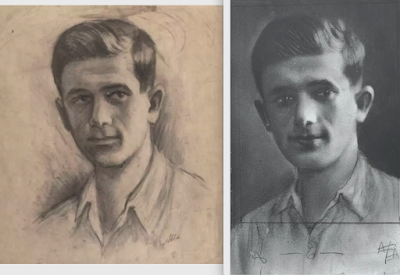Abba Fenichel was born on Nov 13, 1906, in Mielec, Poland, the son of the painter Isak Fenichel and Hena. His brothers were Szymon (born 1897), Ester, in years to come – Ester Goldstein (born 1895) and Leizer (born 1904).
Abba engaged in painting and violin playing from an early age. He graduated art and art teaching studies in 1935 at the Academy of Arts in Krakow (Akademia Sztuk Pięknych im. Jana Matejki w Krakowie).
He married the painter Frida Sternberg during the second half of the 1930'.
He married the painter Frida Sternberg during the second half of the 1930'.
Holocaust
At the outbreak of WWII Abba Fenichel fled to the Soviet Union and was imprisoned in a labor camp in Siberia, where he continued to paint in spite of the harsh conditions.
When the Soviet Union joined the alliance against Nazi Germany and the Polish exiles were liberated in 1941, he was accepted as a member of the painters association of Russia and worked as set designer in the theater.
When the Soviet Union joined the alliance against Nazi Germany and the Polish exiles were liberated in 1941, he was accepted as a member of the painters association of Russia and worked as set designer in the theater.
Abba Fenichel´s entire family perished in the Holocaust: His father Isak perished at an unknown time in the village Berdechow; the mother Hena, the brother Szymon and the sister Ester were murdered in 1942 at Belzec camp; the brother Leizer passed away in the Soviet Union at an unknown date; His wife Tzila perished also in Belzec in 1942. The artist's wife – Frida Fenichel perished at Krakow ghetto in 1942.
Fenichel returned to Poland in 1945 and worked as ilustrator at the Historical Jewish committee (Centralna Żydowska Komisja Historyczna), in years to come – The Jewish history institution (ZIH - Zydowski Instytut Historyczny) and that very same year exhibited his drawings in an exhibition at the National museum of Krakow (Muzeum Narodowe w Krakowie).
Maapilim
Fenichel tried in 1946 to illegally immigrate to Eretz Israel on board the ship "She'ar Yashuv" but the ship was captured and its passengers were deported to a detention camp in Cyprus. For two years Fenichel held painting classes in Cyprus, teaching the inmates of the camp. He also documented the life of the camp in 500 drawings.
Eretz Israel
On June 1948 Abba Fenichel and his second wife Rachel nee Bloch made Aliya to Israel and settled down in Tel Aviv. On August 1948 Fenichel already exhibited his drawings from Cyprus in his first solo exhibition at "Mikra" studio in Tel Aviv. He began teaching art in 1949 at the College for Art teachers in Tel Aviv and at the "People's University", Helena Rubinstein pavilion. He was among the founders of the Bat - Yam painting and sculpturing institute. From 1949 until 1974 he worked as illustrator at the newspapers "Davar" and "Davar Layeladim" (for children). He was also illustrator at several theaters, among them: "HaBima" theater, "Cameri" theater and "HaOhel" theater.
Abba Fenichel's drawings of his illegal immigration voyage and the life at the detention camp in Cyprus were published in in 1965 in the art book "Tales of illegal immigration (HaAppala)".
Throughout his years of work Abba Fenichel held several exhibitions around the world and in Israel as well as illustrated 25 books. Abba Fenichel passed away in Tel Aviv on June 3, 1986.
Abba Fenichel's drawings of his illegal immigration voyage and the life at the detention camp in Cyprus were published in in 1965 in the art book "Tales of illegal immigration (HaAppala)".
Throughout his years of work Abba Fenichel held several exhibitions around the world and in Israel as well as illustrated 25 books. Abba Fenichel passed away in Tel Aviv on June 3, 1986.
From GFH page.



